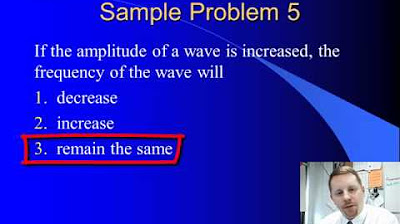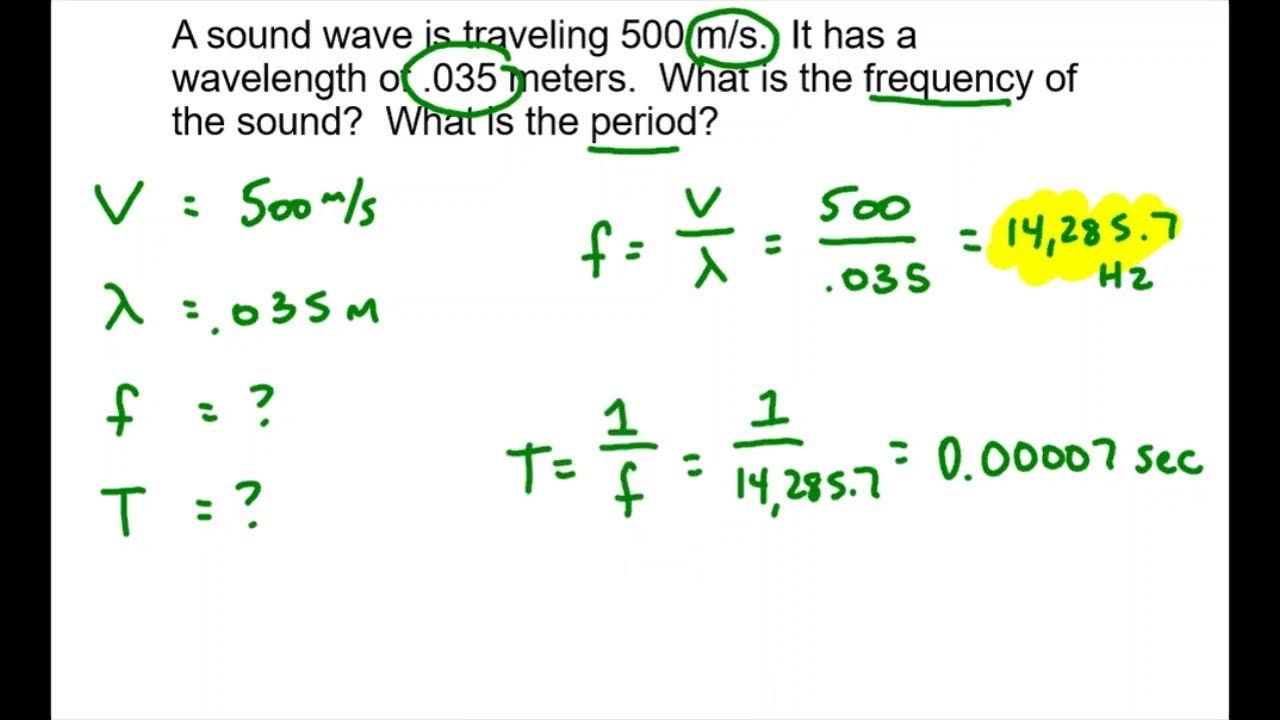💯 Wave Terminology #3/5 Period and Frequency
TLDRThe video script discusses the fundamental properties of waves, focusing on the period and frequency. It explains that the period is the time taken for a wave to travel one wavelength, and is measured in seconds. Frequency, on the other hand, is the number of wavelengths passing a point per second and is measured in hertz. The relationship between the two is reciprocal, with frequency being one over the period. The script further illustrates this concept with an example of a light beam traveling at a speed of 300 million meters per second with a wavelength of 500 nanometers, showing how to calculate its incredibly small period.
Takeaways
- 🌊 The period of a wave is the time it takes for the wave to move one wavelength.
- ⏳ Period is measured in seconds and is crucial for understanding wave properties.
- 📈 Frequency is closely related to the period and is the number of wavelengths passing a point per second.
- 🔄 After one period, a wave looks exactly the same as it did at the start.
- 📊 Frequency is measured in hertz, with 1 hertz equaling 1 wave per second.
- 🔢 The frequency is the reciprocal of the period, calculated as 1 over the period.
- 🌟 Light travels at an incredibly fast speed of 300 million meters per second.
- 💡 Wavelength and period are inversely related; as wavelength increases, period increases and vice versa.
- 📏 To find the period of a wave, use the equation T = λ/v, where T is the period, λ is the wavelength, and v is the velocity.
- 🖥️ When dealing with very small periods, like those of light, it's often more practical to focus on wavelength.
- 🔍 For accurate calculations, ensure all units are consistent and use standard unit conversions (e.g., 1 nanometer = 10^-9 meters).
Q & A
What is the definition of a period in the context of waves?
-The period of a wave is the time it takes for the wave to move one wavelength, or the time for a crest or trough to move from one position to the next equivalent position. It is the duration of a single cycle of the wave and is measured in seconds.
How is the period related to the appearance of the wave?
-After one period, the wave looks exactly the same as it did at the start because the period represents one complete cycle of the wave's motion. This means that the wave has returned to its original state after traveling a distance equal to one wavelength.
What is the definition of frequency in wave properties?
-Frequency refers to the number of wavelengths that pass a fixed point per second. It is the rate at which the wave's crests or troughs move past a certain point and is measured in hertz (Hz), which is equivalent to cycles per second.
How is frequency related to the period of a wave?
-Frequency and period are inversely related. The frequency of a wave is the reciprocal of its period, meaning that if the period is measured in seconds, the frequency will be measured in per second or hertz. Mathematically, this relationship is expressed as f = 1/T, where f is the frequency and T is the period.
What is the significance of the period and frequency in the context of light waves?
-The period and frequency of light waves are significant because they determine the properties of the light, such as its color. For instance, a light wave with a very small period, like that of visible light, will have a high frequency and a short wavelength, which is associated with the visible spectrum. Understanding the period and frequency of light waves helps in the study of optics and the development of technologies like fiber optics and lasers.
How can one calculate the period of a wave given its wavelength and speed?
-To calculate the period of a wave, you can use the equation T = λ/v, where T is the period, λ is the wavelength, and v is the speed of the wave. By substituting the known values of wavelength and wave speed into the equation, you can solve for the period T.
What is the unit conversion required to calculate the period of a light wave with a wavelength given in nanometers?
-To calculate the period of a light wave with a wavelength given in nanometers, you need to convert nanometers to meters. The conversion factor is 1 nm = 10^-9 m. Therefore, if the wavelength λ is given in nanometers, you multiply it by 10^-9 to express it in meters before using it in the period calculation.
What is the period of a light wave traveling at a speed of 300 million meters per second with a wavelength of 500 nanometers?
-To find the period of a light wave with these properties, you first convert the wavelength from nanometers to meters: 500 nm = 500 x 10^-9 m. Then, using the formula T = λ/v and substituting the given values, the period T is approximately 1.67 x 10^-15 seconds.
Why is it often more useful to measure the wavelength of light rather than its period?
-It is often more useful to measure the wavelength of light rather than its period because the period of light waves, especially in the visible spectrum, is extremely small and difficult to measure directly. Wavelength provides a more practical and intuitive way to describe the properties of light, such as color and energy, and is directly related to the frequency through their inverse relationship.
How does the speed of a wave affect its period and frequency?
-The speed of a wave has an inverse relationship with its period and a direct relationship with its frequency. If the speed of a wave increases, the period decreases (meaning the wave completes a cycle more quickly), and the frequency increases (meaning more cycles occur per second). Conversely, if the wave speed decreases, the period increases and the frequency decreases.
What is the significance of the hertz as a unit of measurement for frequency?
-The hertz (Hz) is the SI unit of measurement for frequency, defined as one cycle per second. It simplifies the expression of frequency by providing a more manageable unit than 'per second', especially when dealing with high frequencies. The use of hertz allows for a straightforward understanding and comparison of how often waves complete a cycle.
How does the concept of period and frequency apply to other areas of physics and engineering?
-The concepts of period and frequency are fundamental in many areas of physics and engineering. For example, in electrical engineering, the period and frequency of an alternating current (AC) determine the number of times the current changes direction per second. In acoustics, the frequency of a sound wave corresponds to the pitch heard, while the period can be related to the duration of the sound. These concepts are also crucial in the analysis of mechanical vibrations, radio wave propagation, and signal processing.
Outlines
🌊 Understanding Wave Period and Frequency
This paragraph introduces the concept of the period, a fundamental property of waves, which is the time it takes for a wave to move one wavelength. It explains that the period is measured in seconds and is the duration for a crest or trough to move from one position to the next identical position. The paragraph also discusses the relationship between the period and frequency, where frequency is the number of wavelengths passing a fixed point per second, measured in hertz (Hz). The frequency is the reciprocal of the period, indicating that a smaller period means a higher frequency. The paragraph concludes with an example of calculating the period of a beam of light traveling at a speed of 300 million meters per second with a wavelength of 500 nanometers, demonstrating the conversion of units and the application of the velocity, wavelength, and period relationship.
Mindmap
Keywords
💡Period
💡Wave
💡Frequency
💡Wavelength
💡Speed
💡Crest
💡Trough
💡Reciprocal
💡Hz (Hertz)
💡Light
💡Nanometer
💡SI Units
Highlights
Definition of period in wave properties is introduced, which is the time taken for a wave to move one wavelength.
The period is measured in seconds and signifies the time for a crest or trough to move from one point to the next.
During one period, a wave travels exactly one wavelength, and it looks the same as when it started.
Frequency is closely related to the period and is defined as the number of wavelengths passing a fixed point per second.
Frequency is measured in hertz, with 1 hertz equaling 1 wave per second.
The relationship between frequency and period is that frequency is the reciprocal of the period.
The velocity of a wave is given by the formula of distance over time, which can be rearranged to wavelength over period equals velocity.
To find the period of a beam of light, one must use the formula and substitute the given values for wavelength and velocity.
The wavelength of the light beam is 500 nanometers, which needs to be converted to meters for the calculation.
The conversion rate for nanometers to meters is 10 to the power of minus 9 meters per nanometer.
By substituting the values into the formula, the period of the light beam is calculated to be 1.67 times 10 to the minus 15 seconds.
The incredibly small period of light beams makes it more practical to measure them by their wavelength rather than their period.
The discussion provides a clear understanding of the fundamental concepts of wave properties, such as period and frequency.
The method for calculating the period of a wave is explained in a step-by-step manner, making it easy to follow and understand.
The example of light beams traveling at a speed of 3 times 10 feet meters per second illustrates the application of wave property calculations.
The importance of unit conversion when dealing with different units of measurement, such as nanometers to meters, is highlighted.
The transcript emphasizes the practical use of understanding wave properties in real-world scenarios, like measuring light beams.
Transcripts
5.0 / 5 (0 votes)
Thanks for rating:





